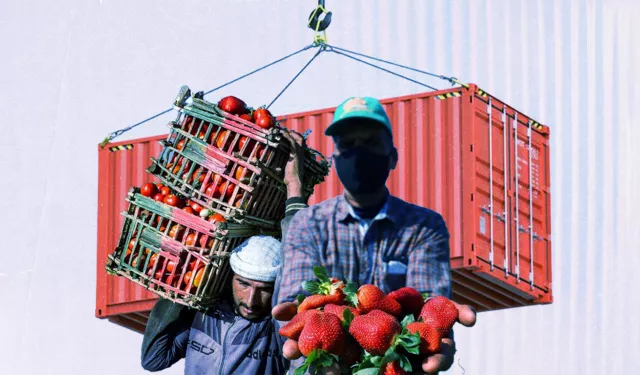
The High Cost of Low Prices| Egypt’s agricultural exports
Egypt’s agricultural exports reached a record $10.7 billion in 2024, and the Ministry of Agriculture is targeting $12 billion in 2025. To many observers, this looks like another success story for Egypt’s economy, especially since it represents nearly one quarter of total goods exports—about $45 billion in 2024—and roughly one-sixth of all exports when services are included.
Yet the headline figure hides a more complex reality. Data from the Multi-Regional Input–Output Database, shows that every one million euros of fruit and vegetable exports from the Middle East consumes about 1.8 million cubic meters of water. Applied to Egypt, this implies that the country’s farm exports require about 18 billion cubic meters of water annually; nearly a third of Egypt’s share of the Nile.
Much of that freshwater leaves the country as virtual water embodied in export crops such as oranges, strawberries, potatoes, and onions.
The strain is not only environmental. The same database indicates that export-oriented agriculture in Egypt requires around 164,000 labor hours for every one million euros in revenue; more than 21 times the average for high-income countries, which need only 7,500 hours to generate equivalent value.
Freshwater toxicity linked to Egypt’s agricultural exports is about 32 times higher than in high-income countries, and the toxic impact on ecosystems is 14 times greater.
Water pollution indicators such as eutrophication and acidification are 93 times worse than those of richer economies.(*) Intensive chemical use, including fertilizers and pesticides, appears to be the main cause. These inputs are central to modern capitalist farming, which focuses on maximizing short-term yield regardless of long-term soil health.
This article continues a series examining the hidden costs of low-price exports. Here, the focus turns to agriculture, unpacking through data the ecological and economic trade-offs behind Egypt’s export boom.
The analysis draws on the Environmentally Extended Multi-Regional Input–Output/EEMRIO database, an EU-developed tool linking global trade flows to environmental and social impacts such as water consumption and pollution, emissions, and labor intensity. It compares the real impact of each million euros of agricultural exports from Egypt with those of higher-income economies.
The price of our water and the price of theirs
Egypt’s $10.7 billion in agricultural exports comes at the cost of about 18 billion cubic meters of water, meaning each cubic meter (1,000 liters) yields no more than $0.60. On a value-added basis—after input costs—the return drops below $0.40.
A Boston Consulting Group report notes that water is globally undervalued: in water-scarce regions, its true worth can reach several dollars per cubic meter.
High-income countries generate around $57 of value added per cubic meter of water, middle-income nations (including Egypt) average about $10, and low-income ones about $3.50. Egypt’s overall economy yields $5.49 per cubic meter—far above agriculture’s $0.60, but still below the world average.
Crumbs from the value chain
Most export crops are price inelastic: higher prices do not sharply reduce demand. Even though crops such as oranges and strawberries are somewhat more elastic than staples, their price sensitivity remains low compared with industrial goods and services. In theory, this allows exporters to raise prices without losing buyers.
According to the very market logic so often celebrated as the guiding principle of global trade, low elasticity should empower sellers to capture greater value. In other words, if demand remains stable despite higher prices, these goods could easily sell for more than they currently do.
One reason agricultural exports remain underpriced is that the export price represents only a small fraction of the final retail price paid by European consumers. For oranges, the Egyptian exporter’s share can be as little as 10% of the retail price. The rest goes to transport, shipping, storage, taxes, and profits for importers and retailers.
This means that even if export prices doubled, the final retail price would rise by only about 10%, an increase easily absorbed by intermediaries and retailers, who together capture roughly 70% of the final price.
Price elasticity also varies by market: Egyptian strawberries, for instance, face low price sensitivity in Germany but higher sensitivity in Saudi Arabia, meaning that gains in one market could offset losses in another.
Subsidizing foreign consumers and middlemen
Curbing the drain on Egypt’s resources and workforce under the current export model begins with reassessing agricultural export subsidies, which total about 3.65 billion Egyptian pounds (around $73 million) per year. These direct subsidies are augmented by indirect support such as access to land, water, energy, credit, and customs facilities, as well as labor laws that keep wages low.
In practice, the water, financial, and human resources directed at fruit and vegetable exports end up subsidizing European and Gulf consumers, who enjoy Egyptian produce at prices that do not reflect its real cost, and trade intermediaries whose profit margins are inflated by Egypt’s low export prices.
Ending or restructuring these subsidies—along with pricing water and energy closer to market value—could both raise export earnings and conserve resources. Redirecting land and water toward domestic staples such as wheat, maize, beans, and oil seeds would also strengthen food security once exports become less artificially profitable.
Such measures would ensure that European consumers bear a fairer share of environmental costs while the Egyptian economy benefits from the water, labor, and land now tied to low-value exports.
If subsidies remain, they should be tied to clear social and environmental conditions. Agricultural wage work in Egypt is often seasonal, physically demanding, and poorly paid, with little health or safety protection, as shown by the recent accident involving female farm workers near Sadat City. Any rethinking of the export model must ensure safer transport, decent wages, proper insurance, and better working conditions.
Transforming the sector along those lines would redefine “success” to include sustainable water and soil use and respect for workers’ rights.
The need for alliances
With exporters locked in a global “race to the bottom,” unilateral reforms are risky. Egypt could instead coordinate with citrus-producing nations such as Spain, Greece, Italy, Turkey, Portugal, and Morocco to manage supply and set fairer prices.
Such alliances could stabilize prices, ease pressure on water systems, and raise revenues without losing markets. They would not be political luxuries but economic necessities—especially given commodity price volatility.
As noted in the previous article in this series, such coordination has historical precedent—from Indonesia’s nickel export ban to China’s restrictions on rare earth metals—and even Egypt’s recent ban on rice exports due to water scarcity.
Higher water prices for export-oriented sectors would also encourage irrigation efficiency and shift more of the true cost onto European consumers and intermediaries. This modest addition compared with other costs in the value chain could help safeguard Egypt’s precious water resources. Competitor countries such as Spain, Morocco, and Tunisia have already faced severe droughts in recent years.
The devaluation trap
Repeated currency devaluations deepen the problem. A 2024 report by EastFruit linked the surge in Egyptian orange exports to the sharp depreciation of the pound. But this “success” came with export prices collapsing to just 15 cents per kilogram.
Between 2008 and 2016—before the pound’s steep devaluation—Egypt’s average orange export price stood at $513 per ton; from 2017–2023 it dropped to $473, and by 2024, just $150. Nominally, that’s an 8% decline over the two periods, but after adjusting for US inflation, the real drop is far steeper.
This dynamic reveals once again how devaluation may boost volumes, but it cheapens the value of every ton exported, eroding the worth of Egypt’s water, land, and labor. The same trend as oranges has dominated global agricultural commodity prices since 2011, following the wave of “structural adjustment” policies that pushed many Global South economies to repeatedly devalue their currencies under IMF supervision after the 2008 financial crisis.
Devaluation, in short, expands exports only by cheapening them and flooding world markets with low-cost goods at the expense of water and human resources. To preserve the value of its work, water, and land, Egypt must reject this ready-made IMF prescription and instead pursue strategies that raise export prices rather than racing to the bottom over who can sell the cheapest to the richest.
(*) Based on my calculations using data from the EEMRIO database https://www.exiobase.eu/. For details on the methodology used to assess the environmental impact of high-income countries, see the methodological paper linked on that site.https://www.researchsquare.com/article/rs-6997348/v2
